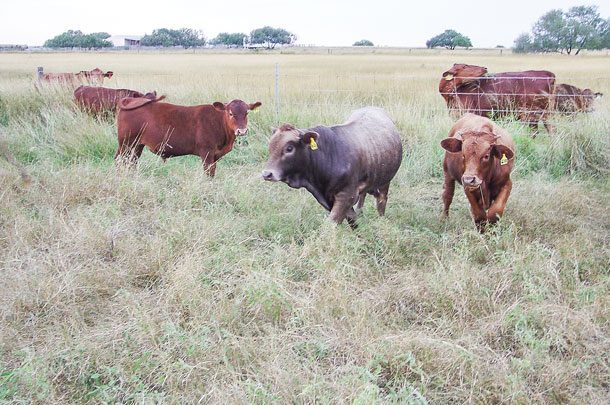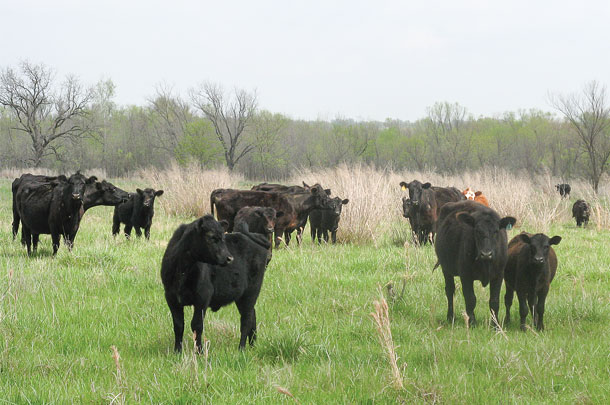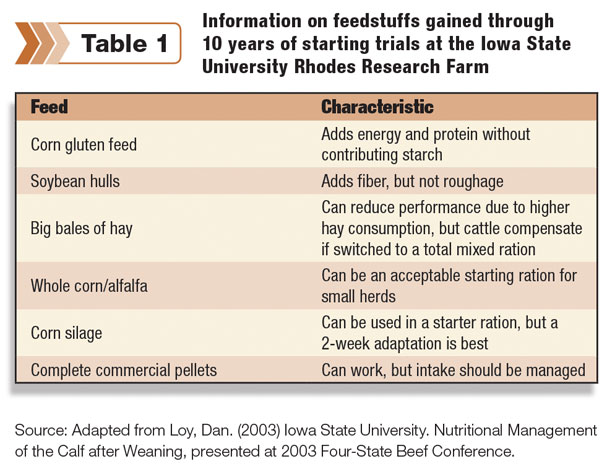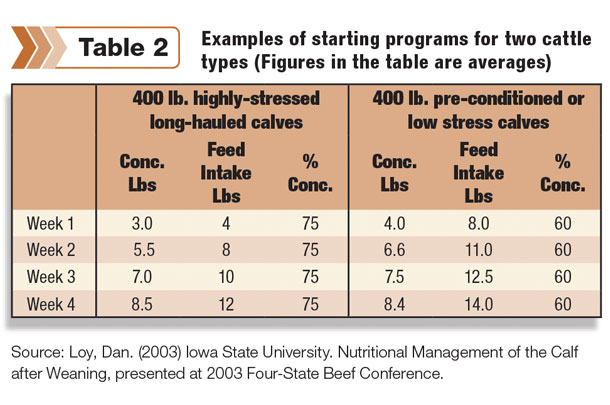Within a month to two months post-birth, calves consume significant amounts of forage, which their dams have taught them to eat.
Unless supplemental feed is available, calves will remain on a milk/forage diet until weaned. At some point in the calf’s life, it will need to learn to eat feed – and there are several ways to transition the animal, but first we must understand how a rumen functions.
A ruminant, such as a cow, sheep, goat or deer, is an amazing animal in that it can convert coarse fibrous material into protein and energy. Cattle utilize roughages and other fibrous feedstuffs through the action of micro-organisms in their rumen.
These micro-organisms are normally obtained from other animals through saliva or ingested on feed.
“Microbes, including bacteria, protozoa and fungi, break down dietary proteins into amino acids and use them to build microbial proteins,” says Rick Machen, Ph.D., Texas A&M AgriLife Extension Service. “Microbial protein serves as a food source for the cow. Approximately 80 percent of a cow’s protein comes from rumen bacteria, and 90 percent of its energy requirements are byproducts of rumination.
“Type of feed eaten by the cow determines the kind of microbe populations that develop in the rumen,” Machen says. “Different rumen microbes digest only specific types of feed."
"Rapid diet changes cull the microbes that are intolerant to the new feed, leaving only a small population of tolerant bugs. To avoid digestion problems for the ruminant, diets must be changed gradually to give the new microbes time to build an adequate-sized population.”
Fenceline weaning
“Fenceline weaning is separating calves and dams into adjacent pastures,” says Rick Rasby, Ph.D., University of Nebraska. “One way to transition calves to feed using this weaning system is to feed supplement for about two weeks before weaning. Dams will teach the calves to eat the supplement.
“Another method is offering calves creep feed for a two- to three-week period before weaning. At the time of weaning, cows are moved to an adjacent pasture, and calves are allowed to remain with the creep feeders.

When using the fenceline weaning technique, consider placing a docile unrelated cow in the pasture with the weaned calves. This animal acts as a companion and teacher, guiding calves to water and feed locations and demonstrating how to use these resources.
“Labor and feeding equipment needs can be reduced by limit-feeding the grain mix through the use of salt that can be provided in a creep feeder,” Rasby continues. “The amount of salt needed in the ration will depend on the desired gain."
"As calves adapt to the salt, some adjustment in the amount may be required so that grain intake is limited to about 1 percent of bodyweight. Concentrate mixtures can be used for this purpose by simply deleting the roughage source and substituting salt and additional grain to make up the difference.”
Drylot weaning
Many producers wean calves and then immediately send them to drylot – either a commercial feedyard or facilities on the ranch. In these situations, it is important to use a systematic approach for transitioning calves from grass to feed, and the process should be implemented over a 21- to 28-day period. Three or four different feed rations are normally used to slowly transition the animals.

“Begin with feeds that the calves are accustomed to,” says Dan Loy, Iowa State University. “If the calves have been creep-fed, the feeds used in the creep should be part of their grain mix at least for the first few days. Calves are adapted to grass, so long-stem hay for the first three to seven days is a normal recommendation."
"Calves usually prefer a dry grain mix at first but will quickly adapt to high-moisture feeds, including corn silage, over a one- to two-week period.”
Table 1 shows various starter feeds tried by Iowa State University, along with the noted advantages and disadvantages of each. Corn products are good starter feeds since they add energy and protein to the diet without contributing starch.

“A large amount of starch in a calf’s diet is not desired,” says Machen. “Starches form fats during rumination, and too much fat makes soap, which coats forage particles, making them indigestible.”
The comments on soybean hulls in Table 1 are also worthy of discussion. “Beef cattle diets deficient in effective fiber can cause permanent damage to the rumen wall,” says Jane Parish, Mississippi State University.
“The effectiveness of fiber for supporting rumen health is positively related to feed particle size. A high level of fiber in the diet does not always indicate that the diet is adequate in effective fiber. If the fiber is chopped or ground too short or too fine, it may not be effective in promoting rumen health. A good example of this is soybean hull pellets.
“Soybean hulls are high in digestible fiber levels, but they are relatively low in effective fiber levels because of a small particle size,” Parish states. “Studies show that effective fiber supplementation improves the performance of cattle fed soybean hull pellets. Therefore, soybean hull pellets should not be used as an exclusive fiber source to replace hay. Finely ground fiber will pass through the digestive system rapidly and will not meet the effective fiber requirements of cattle.”
Loy shows examples of starting programs for two different types of cattle in Table 2. A four-week program was selected because it often takes three to four weeks for cattle to reach normal feed intake. It was assumed that the cattle can tolerate 0.75 percent of their bodyweight in concentrate at the beginning of the feeding period.

This amount may change with different management systems or certain types of cattle.
It is clearly shown in Table 2 that feed intake by the pre-conditioned and low-stress calves were greater than the highly stressed, long-hauled calves. Regardless of their condition, it is important to allow time for weaned calves to develop an appetite for new feeds and for rumen microbes to adapt.
The feed mix should also meet the nutritional requirements of the calves. Unless you have had training in animal nutrition, it is best to hire a consultant or work with a university extension animal nutritionist to develop a diet transition plan. ![]()
Robert Fears is a freelance writer based in Texas.
PHOTO 1: One way to transition calves is to feed supplement for about two weeks before weaning so their dams can teach them to eat it.
PHOTO 2: Cattle utilize forage and other fibrous feedstuffs through the action of micro-organisms in their rumen.
PHOTO 3:Marketing weaned calves without transitioning them to feed creates a lot of animal stress. Photos courtesy of Robert Fears.







